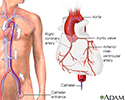Aortic angiography
Angiography - aorta; Aortography; Abdominal aorta angiogram; Aortic arteriogram; Aneurysm - aortic arteriogram
Aortic angiography is a procedure that uses a special dye and x-rays to see how blood flows through the aorta. The aorta is the major artery. It carries blood out of the heart, and through your abdomen or belly.
Angiography uses x-rays and a special dye to see the insides of the arteries. Arteries are blood vessels that carry blood away from the heart.
How the Test is Performed
This test is done at a hospital. Before the test starts, you will be given a mild sedative to help you relax.
- An area of your body, most often in your arm or groin area, is cleaned and numbed with a local numbing medicine (anesthetic).
- A radiologist or cardiologist will place a needle into the groin blood vessel. A guidewire and a long tube (catheter) will be passed through this needle.
- The catheter is moved into the aorta. The doctor can see live images of the aorta on a TV-like monitor. X-rays are used to guide the catheter to the correct position.
- Once the catheter is in place, dye is injected into it. X-ray images are taken to see how the dye moves through the aorta. The dye helps detect any blockages in blood flow.
After the x-rays or treatments are finished, the catheter is removed. Pressure is applied to the puncture site for 20 to 45 minutes to stop the bleeding. After that time, the area is checked and a tight bandage is applied. The leg is most often kept straight for another 6 hours after the procedure. You should avoid strenuous activity, such as heavy lifting, for 24 to 48 hours.
How to Prepare for the Test
You may be asked not to eat or drink anything for 6 to 8 hours before the test.
You will wear a hospital gown and sign a consent form for the procedure. Remove jewelry from the area being studied.
Tell your health care provider:
- If you are pregnant
- If you have ever had any allergic reactions to x-ray contrast material, shellfish, or iodine substances
- If you are allergic to any medicines
- Which medicines you are taking (including any herbal preparations)
- If you have ever had any bleeding problems
You will be awake during the test. You may feel a sting as the numbing medicine is given and some pressure as the catheter is inserted. You may feel a warm flushing when the contrast dye flows through the catheter. This is normal and most often goes away in a few seconds.
You may have some discomfort from lying on the hospital table and staying still for a long time.
In most cases, you can resume normal activity the day after the procedure.
Why the Test is Performed
Your provider may ask for this test if there are signs or symptoms of a problem with the aorta or its branches, including:
- Aortic aneurysm
- Aortic dissection
- Congenital (present from birth) problems
- AV malformation
- Double aortic arch
- Coarctation of the aorta
- Vascular ring
- Injury to the aorta
- Takayasu arteritis
What Abnormal Results Mean
Abnormal results may be due to:
- Abdominal aortic aneurysm
- Aortic dissection
- Aortic regurgitation
- Congenital (present from birth) problems
- Double aortic arch
- Coarctation of the aorta
- Vascular ring
- Injury to the aorta
- Mesenteric artery disease or ischemia
- Peripheral artery disease
- Renal artery stenosis
- Takayasu arteritis
Risks
Risks of aortic angiography include:
- Allergic reaction to the contrast dye
- Blockage of the artery
- Blood clot that travels to the lungs
- Bruising at the site of catheter insertion
- Damage to the blood vessel where the needle and catheter are inserted
- Excessive bleeding or a blood clot where the catheter is inserted, which can reduce blood flow to the leg
- Heart attack or stroke
- Hematoma, a collection of blood at the site of the needle puncture
- Infection
- Injury to the nerves at the needle puncture site
- Kidney damage from the dye
Considerations
This procedure may be done with left heart catheterization to look for coronary artery disease.
Aortic angiography has been mostly replaced by computed tomography (CT) angiography or magnetic resonance (MR) angiography.
References
Grant LA, Griffin N. The aorta. In: Grant LA, Griffin N, eds. Grainger & Allison's Diagnostic Radiology Essentials. 2nd ed. Philadelphia, PA: Elsevier; 2019:chap 2.4.
Reekers JA. Angiography: principles, techniques and complications. In: Adam A, Dixon AK, Gillard JH, Schaefer-Prokop CM, eds. Grainger & Allison's Diagnostic Radiology. 7th ed. Philadelphia, PA: Elsevier; 2021:chap 78.
Review Date: 10/18/2022
Reviewed By: Deepak Sudheendra, MD, MHCI, RPVI, FSIR, Founder and CEO, 360 Vascular Institute, with an expertise in Vascular Interventional Radiology & Surgical Critical Care, Columbus, OH. Review provided by VeriMed Healthcare Network. Also reviewed by David C. Dugdale, MD, Medical Director, Brenda Conaway, Editorial Director, and the A.D.A.M. Editorial team.















